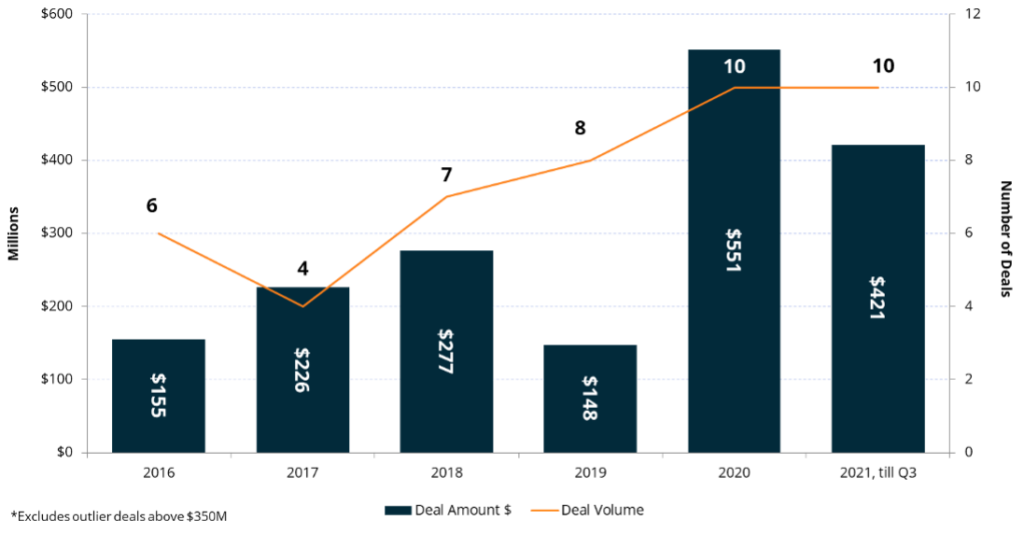How the Construction Industry is Designing Out Carbon
“By changing what we make, we are able to change how we make it” explains Jonathan Scherr, CEO of Juno, an integrated design and supply chain company that designs and builds buildings, alongside construction partners, that reduce waste, have shorter construction timelines and are iteratively more precise and efficient. Juno is one of many construction innovators looking to improve buildings by design.
Our figures show increasing investment in sustainable construction design innovation. These companies streamline the construction process and consider the entire building’s lifecycle from embedded emissions in materials, building energy efficiency through to end-of-life or repurposing.
The superstar in the construction design and prefabrication scale-up market was Katerra, a provider of integrated construction solutions through expertise in design, material sourcing, manufacturing, logistics and technology. Katerra sought to address fragmentation and inefficiencies in the construction industry by combining design and construction services, integrating software and technology at every stage of the build. However In 2021, having raised funding at unicorn valuations, Katerra told its employees to prepare for its shut down citing Covid-19 disruption, the rising cost of labor and materials as major contributors. The company had raised over $2 billion, largely from Softbank’s Vision Fund since it was founded in 2015.
These past two years haves seen considerable investment from the venture capital, corporate and prop-tech investors, a trend which has continued to grow since 2016. So how are the newcomers on the scene different? Or is the construction industry not ready for disruption?

Business Models
Design for Efficiency
Unlike Katerra, Juno’s approach focuses on building expertise and software tools in supply chain management rather than owning lumber mills or prefab assembly plants. This creates predictability for clients and reduces the commercialization risk for both investors and Juno.
Juno’s CEO Jonathan Scherr explains how their ‘productization’ approach enables continuous improvement in construction “by creating buildings that are worthy of being repeated, tools and systems can be created to enable continuous improvement and increase efficiency.”
Building regulations and standards for energy efficiency in new buildings, like France’s RE2020 regulation for new building energy efficiency, are driving the market for efficient design software like digital twins, Building Information Modelling (BIM) and Life Cycle Assessment (LCA) tools. Governments are also investing in innovators:
Design for Efficiency – Recent Activity
June 2021: Vizcab, developer of project management and LCA tools for construction and engineering projects to estimate emissions, raised $1.4 million in Series A funding from investors Banque des Territories and A/O PropTech. Capitalizing on the new French environmental RE2020 Regulation for new buildings. Vizcab has stated it is developing a solution to calculate the carbon footprint of the construction sector.
May 2021: Construcia, provider of circular buildings architecture, engineering, construction, and maintenance services, raised growth equity funding from The Paris Fonds Vert, a fund managed by Demeter Partners and supported by the City of Paris.
June 2021: XYZ Reality, a developer of augmented reality, Virtual Reality and BIM software for the construction industry, raised $27 million in Series A funding.
Prefabricated housing
Prefabricated buildings and modular construction methods are not new, but the approach of constructing elements off-site has seen a resurgence with a focus on sustainability. Prefabricated or modular structures can be standardized and built quicky using a production line, avoiding waste and reducing costs by up to 20%, according to Christian Lawrence, Rise Modular’s CEO. Construction can also be automated using robotics and 3D printing enabling 24/7 construction, speeding up construction time. The factory setting also avoids damage or disturbance from weather compared to on-site construction.
We spoke to Kaustubh Pandya, Principal at construction technology investor Brick & Mortar Ventures, who explained why prefabricated construction was seeing a resurgence in 2021:
“The pandemic provided strong tailwinds for prefabrication, as contractors sought to better manage work in predictable and safe working conditions – both in the short term and the long-term. The conversation quickly flipped to how much can we prefab.’ US-based Brick & Mortar are one of a handful of construction technology focused investors. In May 2019, Brick & Mortar and Virgo Investment Group led a $10.8 million Series A round for Connected Homes, a prefab modular housing provider. Kaustubh explained his outlook on the prefab market ‘my advice to innovators is to keep it simple and scale gradually, be clear of what vertical you want to play in (e.g. single-family vs multifamily). Are you making housing affordable or affordable housing? The risk profile, the go-to-market, and inherently how you approach scaling is very different in each of those efforts. How to optimize company legal structure fit for that vertical, navigate permitting, and securing strong partnerships with logistics operators are also key factors for success.”
The popularity of prefabricated design has resulted in considerable investment activity in 2021. In July, Mighty Buildings, provider of prefabricated single-family housing solutions using 3D printed thermoset composite panels, raised $22 million in a Series B round extension following a $40 million Series B raise in February. The company plans to use the funding to scale operations in North America following high consumer demand.
Prefabricated buildings Recent Activity:
October 2021: Developer of modular, prefabricates and affordable housing solutions Indie Dwell raised $5.6 million in a Series A round from undisclosed investors.
September 2021: Juno, provider of end-to-end development for prefabricated buildings and software developer of platform to determine the most efficient, fast and sustainable construction methodology raised $20 million in a Series A round from investors Comcast Ventures, Khosla Ventures and Real Estate Technology Ventures.
August 2021: Plant Prefab, designer of prefabricated home-building technology for the urban in-fill market, raised $30 million a Series B round.
July 2021: Mighty Buildings, Provider of prefabricated home building service via 3D printing, raised $22 million building on its February Series B round which raised $40 million.
May 2021: Prescient, developer of building design software and building frame production facilities that use low gauge, rolled steel to produce modular building frames without the use of wood or concrete, raised $190 in a Growth Equity round from long-term investor Eldridge Industries and construction company JE Dunn.
Competition
The construction industry is highly complex, diverse and fragmented leading to similarly diverse and fragmented incumbents in building design. For example, In 2020 media group, Vox Creative; RV Builder, Escape and flat-pack furniture producer, Ikea all launched a prefabricated ‘tiny home’ for sustainable single-resident living.
There have also been a few notable exits in this space including Procore, a developer of cloud-based construction management and design software. In May 2021, Procore listed on the New York Stock Exchange for $592 million. Procore have continued to expand its offering and in September 2021 the company acquired construction payments innovator, Levelset for $500 million in cash and stocks.
To answer the initial question, it seems the construction industry is open to innovation, especially with increasingly regulatory pressure for new building sustainability. The newcomers on the scene are improving their chances of success by being flexible but also clear on their value proposition and can be resilient in the highly cyclical beast that is the construction market.
What to watch…
In design, some have started to pool prefabricated building designs to create more standardised structures and continually improve housing, corporate and industrial structures, and even civil infrastructure. For example, The European Union and Microsoft host Green Prefab, an online marketplace for prefab building design. The platform seeks to democratize prefabricate building design enabling early business models, while promoting zero-energy modular buildings.
Taking this one step further, coal to nuclear infrastructure developer TerraPraxis and design consultants Bryden Wood are utilizing modular and standard design to quickly scale low-carbon energy infrastructure. Not-for-profit TerraPraxis’s Repowering Coal project seeks to repurpose coal plant sites to clean energy plants, maintaining workforce and energy output. The key to the project’s success is its fast and repeatable design, which Bryden Wood has helped develop. Bryden Wood’s standardized, and prefabricated construction approach reduces the cost and time of construction by 40-80%. Their approach speeds up the licencing process by standardizing each plant. They are also working with US and Canadian regulators to fast-track approval which in notoriously long and arduous in nuclear.
In short, the modular design methodology can fast track the construction of the low carbon economy.



